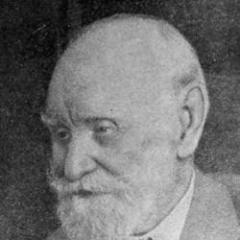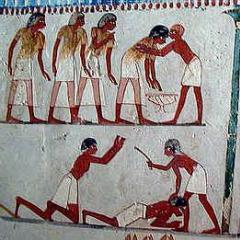The role of Sechenov in the study of VND. The role and contribution of I.M. Sechenov and I.P. Pavlov in the creation of the doctrine of higher nervous activity
I.M. Sechenov and I.P. Pavlov developed a theory of higher nervous activity.
I. M. Sechenov (1829—1905)
The scientific views of Ivan Mikhailovich Sechenov were formed in the 50-60s of the last century under the influence of the ideas of L. I. Herzen, N. G. Chernyshevsky, D. I. Pisarev and V. G. Belinsky. Being materialists, they called for the development of natural sciences, since these sciences spread the ideas of materialism and help fight religion.
I.M. Sechenov studied the functioning of the brain. He proved that the work of the brain is caused not by the “soul”, but by the external world acting on the senses, in response to which various reflexes are carried out. I.M. Sechenov believed that reflexes lie at the basis of mental activity.
He revealed the connection between the psyche and physiological processes and showed that it can be studied. The book in which the research results were presented was called “Reflexes of the Brain” by I.M. Sechenov.
With all his works, I.M. Sechenov proved that the psyche is a property of brain functions. He laid the foundation for the doctrine of higher nervous activity.
 I. P. Pavlov (1849—1936)
I. P. Pavlov (1849—1936)
Ivan Petrovich Pavlov was born into the family of a priest. While still studying at theological school, I. P. Pavlov began reading books by N. G. Chernyshevsky and D. I. Pisarev. He broke with religion in his youth. I. M. Sechenov’s book “Reflexes of the Brain” had a huge influence on I. P. Pavlov. In 1870, I. P. Pavlov entered the natural sciences department of the university in St. Petersburg.
For several decades, I.P. Pavlov studied the activity of the brain of higher animals. He created a scientific method for studying the functioning of the brain and discovered conditioned reflexes. Considering mental activity as a function of the cerebral cortex, I.P. Pavlov created the doctrine of higher nervous activity. As a result of experiments on animals and observations of people, I. P. Pavlov and his many students proved that reflex reactions underlie mental processes. The heyday of I. P. Pavlov’s scientific activity occurred in the last 15 years of his life.
Higher and lower nervous activity
The activity of the animal brain, which ensures the existence of the organism as a single whole, was called lower nervous activity by I. P. Pavlov. It consists in regulating the functions of organs and is based on unconditioned reflexes.
I. P. Pavlov called the activity of the brain that ensures the behavior of the animal higher nervous activity. It supports and preserves the life of the animal. With its help, animals adapt to environmental changes. Conditioned reflexes are the basis of higher nervous activity. Higher and lower nervous activity are inherent in humans. However, the higher nervous activity of humans is much more complex than that of animals. It includes 6 oneself and the complex mental activity of the brain.
“Human Anatomy and Physiology”, M.S.Milovzorova
A person constantly achieves certain goals throughout his life. This is always associated with overcoming certain difficulties. In some cases, initiative is required, in others - power over one’s feelings, resistance to other people’s influence, etc., i.e., will and volitional qualities are manifested. They are especially important in the studies and creative activities of ballet dancers. High willpower...
Type of higher nervous activity By strength By balance By mobility Type of temperament Strong Strong Balanced Mobile Sanguine Unrestrained Strong Unbalanced Mobile Choleric Calm Strong Balanced Sedentary Phlegmatic Weak Weak Unbalanced Sedentary Melancholic Each type of higher nervous activity corresponds to a certain temperament and is its basis. Correlation between types of nervous activity and temperaments. Strong type - sanguine - sociable,...
The similarity of the higher nervous activity of humans and animals. The basic patterns of higher nervous activity were established in experiments on animals. But for the most part they are also characteristic of humans. In the human nervous system, the processes of inhibition and excitation constantly interact. Reflexes are inhibited and stimuli are distinguished. Conditioned reflexes begin to be developed in humans from the very first days of life. Animals have conditional...
What are the merits of I.M. Sechenov and I.P. Pavlov in the development of the doctrine of higher nervous activity?
Answers:
In the book “Reflexes of the Brain,” the scientist I.M. Sechenov proved that a reflex is a universal form of interaction of the body with the environment, that is, not only involuntary, but also voluntary - conscious movements have a reflex character. I.M. Sechenov was the first to describe inhibitory processes developing in the central nervous system. In a frog with destroyed cerebral hemispheres of the brain, the scientist studied the reaction to irritation of the hind leg with an acid solution: in response to a painful stimulus, the leg bent. Sechenov discovered that if in an experiment a salt crystal is first applied to the surface of the midbrain, the time until the response will increase. Based on this, he concluded that reflexes could be inhibited by some strong influences. A very important conclusion made by scientists at the end of the 19th - beginning of the 20th centuries was the conclusion that any response of the body to a stimulus is always expressed by movement. Any sensation, consciously or unconsciously, is accompanied by a motor response. Experimental evidence of the truth of I.M. Sechenov’s ideas was obtained by the great Russian physiologist Ivan Petrovich Pavlov (1849-1936). It was he who introduced the term “higher nervous activity” into scientific language. He believed that higher nervous activity is equivalent to the concept of “mental activity.”
What contribution to science will you learn from this article.
Sechenov Ivan Mikhailovich contribution to science briefly
Sechenov's contribution to physiology cannot be overestimated. He is the founder of the physiological school, which he finally formed in 1868. While doing research in the field of physiology, he wrote a book called “Physiology of the Nervous System.” Even today it is considered fundamental knowledge for the study of those processes that occur in the organisms of living beings.
His physiological school functioned at the Medical-Surgical Academy, St. Petersburg, Novorossiysk and Moscow universities. He was the first to introduce a new method into the practice of giving lectures - demonstrating experiments. He conducted experiments and research in the fields of biology, psychology and medicine.
In 1862, in Bernard's laboratory, he tested an experimental hypothesis regarding the influence on the motor activity of brain centers. Another important contribution of Sechenov to the development of physiology is the concept he developed about nonspecific brain systems.
Sechenov's contribution to medicine
He was the first to completely extract all gases from the blood and calculate their amounts in red blood cells and serum. Sechenov achieved important results by studying the role of erythrocytes in the processes of transfer and exchange of carbon dioxide. The scientist was the first to prove that in red blood cells carbon dioxide is in a state of not only physical dissolution, but also a chemical unstable compound with hemoglobin. The result of Sechenov’s research is the conclusion that red blood cells are carriers of oxygen to tissues from the lungs and carbon dioxide to the lungs from tissues. Also, the academician, together with Shaternikov, developed a portable breathing apparatus.
Sechenov's contribution to psychology
In 1873, Sechenov published Psychological Studies, which became the result of his contribution to psychology. He explored, quote, “a radical shift of the starting point of psychological thinking from the directly given phenomena of consciousness, which for centuries were considered the first reality for the knowing mind, to objective behavior.”
But the real revolution in the field of psychology was a scientific work called “Elements of Thought,” published in 1879. Before this, no one had been able to clearly formulate the principles of human thinking.
Emphasizing the achievements of physiology in the field of sensory organs, he developed a theory about muscle as an organ of cognition of the temporal-spatial relations of things. The muscle, sending sensory signals, allows the mind to build images of external objects and subject connections.
Sechenov's contribution to biology
While doing experiments on the vagus cardiac nerve of a turtle, Sechenov discovered the inhibitory action. He concluded that strong nervous stimulation activates motor reflexes, which are replaced by depressed reflex activity. This pattern was later called the Sechenov reflex.
The academician also conducted experiments on the brain of a frog. First, he made cuts on them and then carefully observed the reflexes of each particle. As a result, he came to the conclusion that there are centers in the brain that delay reflected movements.
We hope that from this article you learned what contribution Sechenov made to science.
THEM. Sechenov (Fig. 54) was a physiologist of a wide range. His research covered many aspects of physiological science. However, he showed a special interest in the physiology of muscles and nerves.
After graduating from St. Petersburg University, I.M. Sechenov finally chose physiology as his specialty and went abroad to improve himself. There he worked for famous physiologists of that time - I. Muller, E.G. Dubois-Reymont, C. Bernard, K.F.V. Ludwig, G. Helmholtz. Already at the beginning of his scientific activity abroad, I.M. Sechenov is distinguished by his desire for independent research, carried out in an original and thorough manner.
Upon returning from abroad, Sechenov actively developed scientific activities at the Department of Physiology of the Medical-Surgical Academy in St. Petersburg. At that time he was especially interested in the physiology of the nervous system.
In 1862, Sechenov discovered the presence of central inhibition in the brain, proving this with a simple but convincing experiment. The frog's hemispheres were removed, but the interstitial brain (visual thalamus) was left. By placing table salt crystals on the visual hillocks, he caused a sharp slowdown in the formation of the arc of the flexion reflex. This discovery brought Sechenov worldwide fame.
Soon he published his wonderful treatise “Reflexes of the Brain,” in which he shows that mental phenomena by their nature are reflexes of the brain. Mental activity, Sechenov argues, is impossible without external stimulation of the senses. All acts of conscious and unconscious life, according to their mode of origin, are reflexes. In daily conscious life, a person cannot renounce the influence on him from the outside through the senses and from the feelings coming from his own body. They support his entire mental life. Thus, Sechenov affirms the position that the content of the human psyche is the material world, reflected in the form of sensations, ideas, and concepts.
Merits of I.M. Sechenov’s achievements before Russian and world science are enormous and undeniable. K.A. Timiryazev called Sechenov the father of Russian physiology, who created the school of Russian physiologists. Among Sechenov’s students there were a number of prominent scientists, such as V.V. Pashutin, B.F. Verigo, SV. Kravkov, V.Ya. Danilevsky, M.N. Shaternikov. Particularly noteworthy is the name of one of Sechenov’s talented students - N.E. Vvedensky, whose research on the physiology of nerves
However, I.M. Sechenov expressed a number of propositions about the strict conditionality of the functioning of the brain, without relying on any large amount of experimental material. Experimentally, the patterns underlying higher nervous activity were obtained by I.P. Pavlov and his school.
Rice. 55. I.P. Pavlov
The role of I.P. Pavlov (Fig. 55), one of the greatest naturalists of the late 19th - early 20th centuries, is truly enormous. He managed to create a completely new section in science, and, moreover, one of the most complex - the physiology of the cerebral hemispheres. Before Pavlov’s work, the physiology of the brain as a coherent scientific system of knowledge did not exist. Works devoted to the physiology of the brain and nerves were very scattered. Pavlov’s greatest merit is that, having created his original method of conditioned reflexes, using it to study the physiological mechanisms of cortical activity, he at the same time synthesized all the experience of the past, testing and clarifying a number of provisions with numerous, extremely accurate experiments.Thus, Pavlovian physiology is characterized by the breadth of scientific thought and a comprehensive study of the subject; it is aimed at generalizing mass factual material, as a result of which it is predominantly synthetic in nature. Previous studies that developed various particular issues of neurophysiology were analytical in nature and could not rise to the level of a broad generalization of the facts found. A brilliant stroke of Pavlovian thought was needed to bring into a coherent system the mass of acquired, sometimes contradictory facts obtained as a result of past experience and his own experiments, amazing in their perfection, in order to create a new doctrine about the higher nervous activity of animals
and man.
The doctrine of higher nervous activity associated with the names of I.M. Sechenov and I.P. Pavlova, built on the reflex principle. A reflex refers to the body’s response to irritation of the external environment, carried out through the nervous system. Recognizing that the existence of organisms is possible only in connection with the external environment, Pavlov pointed out that interaction is carried out with the help of special connections, or reflexes. A reflex, according to Pavlov, is a connection that is established between one or another agent of the external environment with one or another activity of the body, carried out through a system of nerve receptors.
The reflex theory is based on the following basic principles:
principles:
The principle of determinism is that every phenomenon has its own cause, a certain impetus, a reason for its development. Hence, a truly scientific study of a particular phenomenon must first of all find out the reasons for its origin.
The principle of structure. Arguing that the physiological basis of higher nervous activity is the formation of neural connections (conditioned reflexes) reflecting the external world, Pavlov at the same time attributed the formation of conditioned reflexes to the structures and systems of the brain, which in each nervous act enter into new functional relationships.
3. Principle of analysis and synthesis. The cerebral cortex receives countless irritations from the external world, as well as impulses from the internal environment (internal organs). This makes it necessary to first differentiate the complex of incoming stimuli, which occurs through analysis. At the same time, to regulate all processes occurring in the body, to create appropriate forms of adaptation to the external environment, it is necessary to generalize the stimuli identified by the analysis, i.e. synthesis. Thus, through analysis, the neural connection can be divided into large fractions. Synthesis causes the unification of many connections into an integral functional system. Analysis and synthesis are the main physiological mechanism of cortical activity. In his experiments, I.P. Pavlov combined methods of analysis and synthesis and achieved depth and comprehensiveness in the study of the subject.


